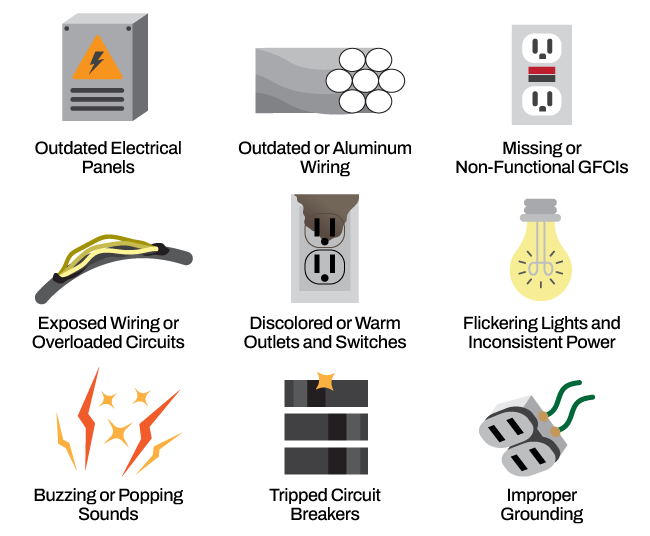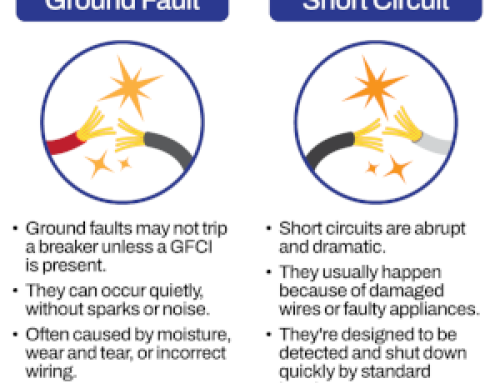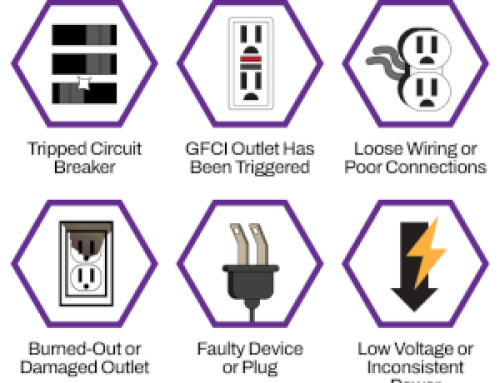Buying a home is one of the biggest investments you’ll ever make, but hidden electrical issues can turn that dream purchase into a costly, dangerous headache.
From outdated wiring to overloaded panels, many homes come with electrical systems that aren’t ready for modern living.
In this article, we’ll walk you through the most important electrical red flags to watch for during a home inspection. You’ll learn what each issue means, why it matters, and how to move forward with confidence.

1. Outdated or Dangerous Electrical Panels
Your home’s electrical panel is its command center. If it’s outdated or showing signs of problems, it may not safely handle modern energy demands or protect your home from electrical hazards.
Panel Warning Signs:
- Panels over 30 years old that may not meet current safety standards
- Breakers that don’t trip properly during overloads, creating fire hazards
- 100-amp service or less may be insufficient for modern homes (200-amp is standard for homes over 2,000 sq ft)
- Overcrowded panels with double-tapped breakers signal unsafe installations
- Rust or corrosion indicates moisture problems that compromise safety
- Panel replacement typically costs $1,300-$3,000, but it’s essential for safety and often required for insurance coverage.
2. Outdated Wiring Systems
Older homes may have wiring systems that pose serious safety risks:
Aluminum Wiring (1960s-1970s)
Aluminum expands and contracts more than copper, loosening connections and creating fire risks.
Warning Signs:
- Hot outlets or light switches
- Flickering lights without an obvious cause
- No visible COPALUM connectors (used in safe aluminum wire retrofits)
Knob-and-Tube Wiring (Pre-1950)
This obsolete system lacks ground wires and uses ceramic insulators that can fail over time.
Dangers:
- No equipment grounding for safety
- Insulation breakdown leads to fire risk
- Cannot handle modern electrical loads
Full rewiring costs $8,000-$15,000 but may be necessary for safety and insurance compliance.
3. Missing or Non-Functional GFCIs
GFCIs (Ground Fault Circuit Interrupters) are life-saving devices that cut power within 1/40th of a second when they detect current leakage.
Required Locations (Modern Code):
- Kitchens (within 6 feet of sinks)
- Bathrooms (all outlets)
- Laundry rooms
- Garages and unfinished basements
- Outdoor outlets
- Pool and hot tub areas
Missing GFCIs in these areas is a code violation and a safety hazard. Installation costs $150-$350 per outlet but provides invaluable protection.
4. Insufficient Electrical Capacity
Many older homes have electrical service that can’t meet modern demands.
Capacity Red Flags:
- 60-amp or 100-amp service in homes over 1,500 sq ft
- Frequent breaker tripping (more than once per month)
- Lights dim when major appliances start
- Need for multiple extension cords in normal use
Modern homes typically need 200-amp service to safely power HVAC systems, kitchen appliances, electric vehicles, and home offices.
5. Missing Arc Fault Protection
Arc Fault Circuit Interrupters (AFCIs) detect dangerous electrical arcing and are required in bedrooms, living areas, and hallways in modern homes.
Signs of Missing AFCI Protection:
- Standard breakers in bedrooms and living areas
- Homes built before 2002 without electrical updates
- No AFCI labeling on panel breakers
While not always required for existing homes, AFCI protection significantly reduces fire risk from damaged wiring.
6. Exposed Wiring and Code Violations
Open junction boxes, dangling wires, or excessive use of extension cords indicate amateur DIY work or dangerous conditions.
Warning Signs:
- Uncovered junction boxes or exposed wire splices
- Extension cords as permanent wiring
- Wires running through unprotected areas
- Missing wire nuts or electrical tape on connections
These violations often hide more serious problems and require immediate professional attention.
7. Discolored Outlets and Switches
Heat damage around electrical devices indicates loose connections, overloading, or arcing—all potential fire hazards.
Look For:
- Brown or black marks around outlet faces
- Warm switch plates or outlets
- Burning smells near electrical devices
- Melted or deformed plastic components
These signs require immediate electrical evaluation and often indicate hidden wiring problems.
8. Electrical System Warning Sounds
Electricity should operate silently. Any sounds from electrical components signal immediate problems.
Dangerous Sounds:
- Buzzing or crackling from outlets or switches
- Popping sounds when operating switches
- Humming electrical panels (beyond normal transformer hum)
These typically indicate arcing wires, loose terminals, or failing breakers requiring urgent professional attention.
9. Improper or Missing Grounding
Proper grounding safely channels fault currents and prevents dangerous shocks.
Grounding Problems:
- Two-prong outlets throughout the house (no equipment ground)
- Missing ground wires in the electrical panel
- Ungrounded metal appliances that cause mild shocks
- No grounding electrode (ground rod or water pipe connection)
Grounding retrofits can be labor-intensive ($1,000-$3,000) but are essential for safety and code compliance.
What Buyers Should Do When Red Flags Appear
Discovering electrical issues during inspection doesn’t have to derail your home purchase.
Here’s how to respond strategically:
Get Professional Evaluation
Have a licensed electrician review the inspection report and provide written estimates for necessary repairs. This gives you concrete data for negotiations and helps prioritize safety issues.
Negotiate Strategically
- For Major Issues (panel replacement, rewiring): Request seller credits or repairs before closing.
- For Safety Violations (missing GFCIs, exposed wiring): Insist on immediate correction.
- For Code Updates (AFCI installation): Consider as future improvement budget items
Prioritize by Risk Level
- Immediate Dangers: Exposed wiring, dangerous panels, missing GFCIs
- Code Compliance: Grounding issues, capacity problems
- Future Improvements: AFCI installation, panel upgrades for convenience
Document Everything
Keep copies of inspection reports, electrician evaluations, and repair agreements. These protect you legally and help with future resale value.
Remember: Electrical safety issues are legitimate grounds for renegotiation. Most sellers prefer to address these concerns rather than lose a sale.
Frequently Asked Questions
Empower Your Homebuying Journey with Safety First
Electrical red flags shouldn’t scare you away—but they should make you pause and investigate. Whether you choose to walk away or negotiate electrical repairs, knowing the warning signs empowers you to make a safer, smarter decision.
At Brand Home Service, we’re here to help you evaluate inspection reports, perform second-opinion electrical assessments, and make sure your future home is code-compliant and move-in ready.
Call us to schedule a consultation for electrical repairs in Lafayette, IN, and walk into your new home with confidence.



